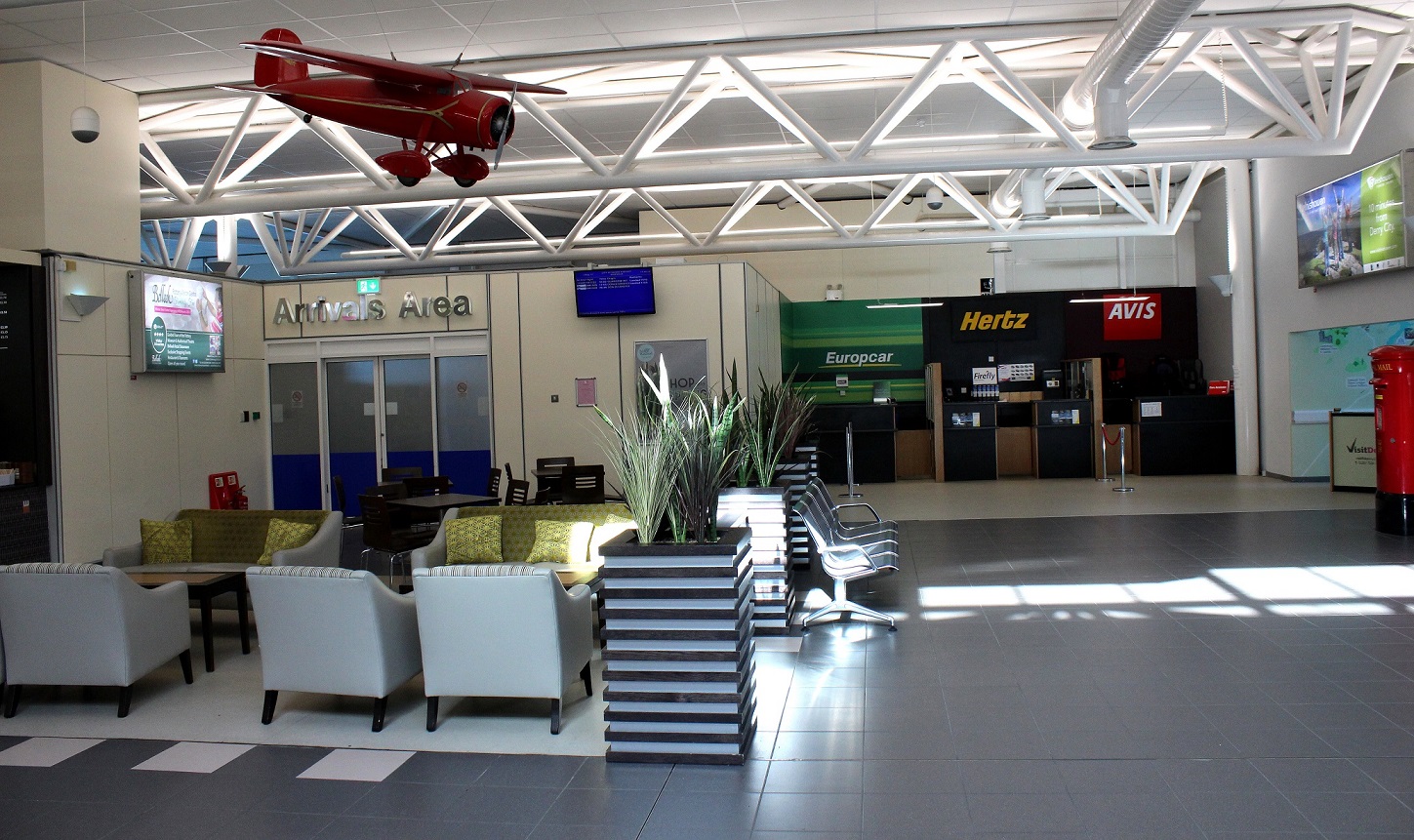Eglinton
EGLINTON: Military aerodrome, Royal Naval Air Station, later civil regional airport
(Later known as LONDONDERRY EGLINTON AIRPORT and later still CITY OF DERRY Airport)
Note: This picture (2017) was obtained from Google Earth ©
Military users: WW2: RN (HMS GANNET) Formation & Working Up (Fighters)
1847 Sqdn (Grumman Hellcats)
RAF Fighter Command 13 Group
41 Sqdn (Vickers-Supermarine Spitfires)
133 and 134 (Eagle) Squadrons (Hawker Hurricanes)
Operated by: 1980s to 2001: Derry City Council
PICTURE GALLERY 2017
British airline users: Post 1945: British Midland, Brymon Airways, Emerald Airways, Flybe, Jersey European Airways, Loganair
Foreign airline users: Post 1945: Aer Arran, Aer Lingus, ASL Airlines Ireland, Ryanair
Flying club/school: Post 1945: Eglinton Flying Club
Location: N of A2, 8nm NE of Londonderry
Period of operation: Military 1941 to 1966. Open to private aircraft in 1975 but in 1985 recorded as being disused. Obviously open again in 1990?
Note: This map is reproduced with the kind permission of Pooleys Flight Equipment Ltd. Copyright Robert Pooley 2014:
Runways: WW2: 03/21 1006x46 hard 08/26 1463x46 hard
15/33 1006x46 hard
1990: 03/21 1004x46 hard 08/26 1472x46 hard
2001: 03/21 1204x46 hard 08/26 1817x46 hard
As this airport map shows, scanned from the AAIB Bulletin: 1/2007, the 03/21 runway had by then been been re-designated as 02/20. This is because the magnetic North Pole, which of course magnetic compasses rely upon - doesn't stay still - it moves, albiet fairly slowly at around 34 to 37 miles a year. Pilots need to be aware of this, but it doesn't make much difference to those flying small aircraft of limited range as I once did.
Needless to say, even when studying to be a private pilot, it is generally expected that an appreciation of the subject needs to be understood. For example there is not one North Pole, but three. The Magnetic North Pole, the Geographic North Pole which explorers seek, and the North Geomagnetic North Pole. All seperated by quite considerable distances. And yes, I will happily admit, having a memory akin to a goldfish apparently, I had to Google it up before making these notes.
NOTES: In 1977 it seems only two aircraft were based here, the Cessna F.150G G-AVHF and Beech B24R Sierra G-BBXU.
A NOVEL FEATURE
In the AAIB report EW/C2006/03/07 it states, “A feature of this airfield is that a single track railway line crosses the Runway 26 extended centreline, very close to the start of the runway, and aircraft inbound to this runway are sequenced to avoid trains.” This certainly is a novel feature especially as, in the mid 2000s at least, airliners at least as large as Airbus 320s were in use here. The report goes on to note, “Aircraft will not be permitted to land on Runway 26 or depart 08 from 5 minutes before the passage of a train until the train is past. Aircraft may experience approach delays of up to 10 minutes where movements conflict with the passage of a train.” Is this the only UK airport where fairly large airliners have to “give way” to trains?
AN 'INTERESTING' SITUATION
The AAIB report EW/G2009/05/33 gives details of the CEA DR300 /180R glider tug (G-BVYG) having the right main wheel being seen to fall off, by glider pilot being towed! Taking off from the “Ulster Gliding Club” at Bellarena, the pilot elected to land here on the disused 02 runway which was, thankfully, pretty straightfoward with minimal damage and no injuries.
I think the tug pilot should certainly be admired, not only for making the decision to land somewhere with full emergency facilities, but also electing to land on a disused runway thereby creating the minimum of bother to the general running of this airport.
A FEW MORE PICTURES IN 2017
AIRPORT STATISTICS
As is so often the case, these can be very revealing, and the history of commercial airline operations reveals that the airport seems to often struggle to keep the momentum going. The boom years being roughly between 2006 and 2011. Perhaps needless to say, any regional airport can often suffer from circumstances changing completely beyond their control.
YEAR NUMBER OF PASSENGERS NUMBER OF MOVEMENTS
1997 50,043 3,121
2000 162,704 4,736
2006 341,586 4,748
2011 405,697 3,839
2016 290,671 1,920
These figures show that, at a regional airport with a reasonable amount of GA (General Aviation) activity, there is no correlation between the amount of movements and the number of passengers using the terminal. There have never been many international airline services, (if you discount flights to the Republic of Ireland of course which strictly speaking are international), but on my visit in May 2017 I was told that flights to Portugal would shortly be commencing.
We'd love to hear from you, so please scroll down to leave a comment!
Leave a comment ...
Copyright (c) UK Airfield Guide






























